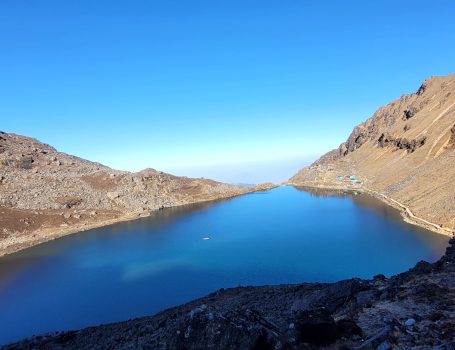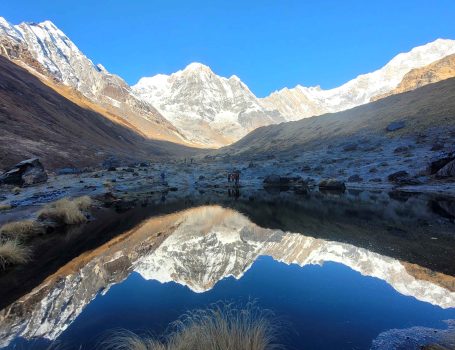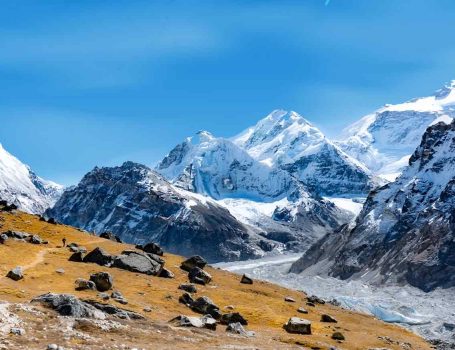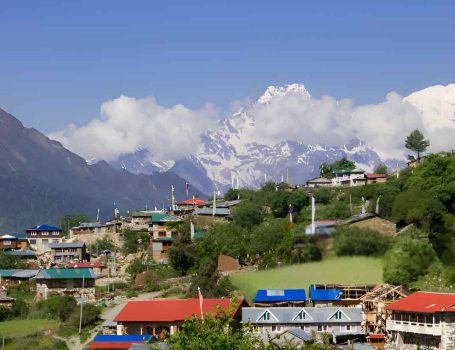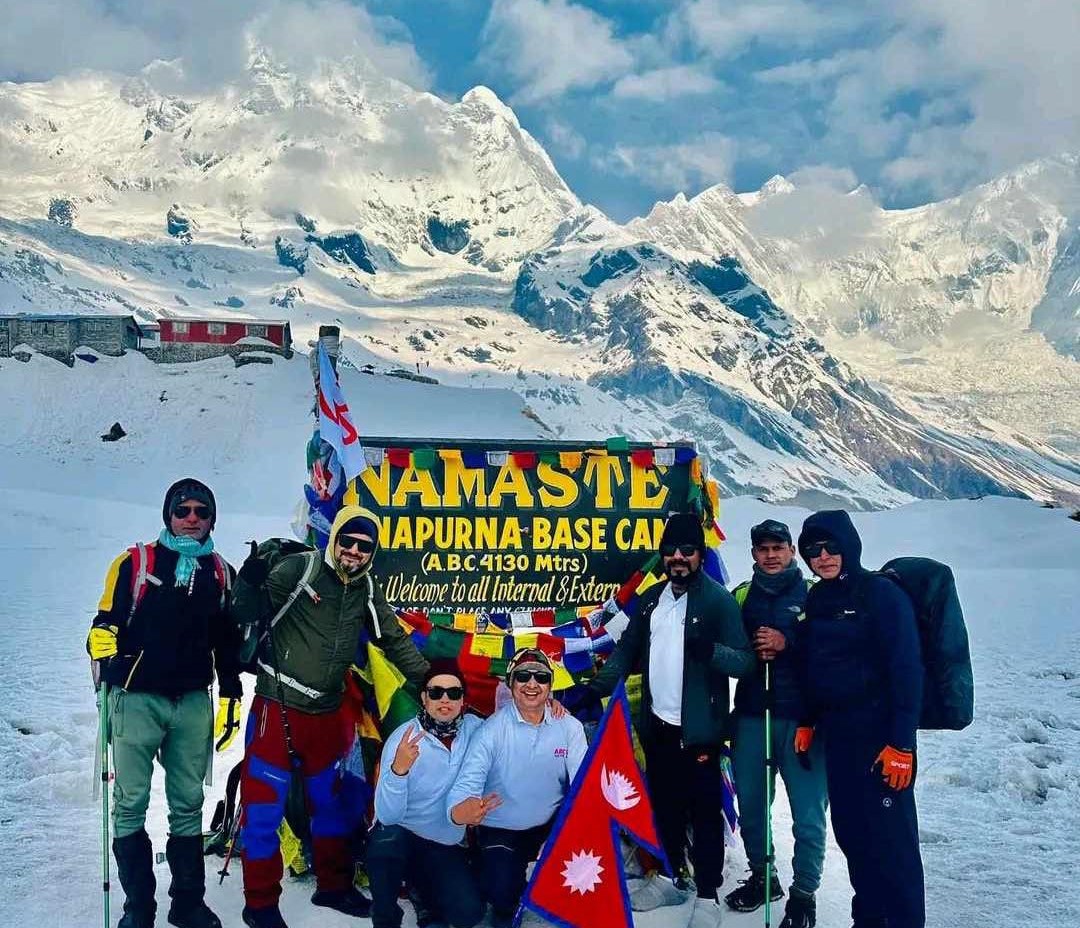Everest Base Camp Trek with Heli Fly Out
Special Offer

Trip Facts
- Duration 11 Days
- Trip Difficulty moderate
- Max. Altitude 5,364 M
- Start and End Kathmandu - Kathmandu
- Best Time Spring & Autumn
- Accommodation Tea House
Trip Highlights
- Enjoy the thrilling and scenic flight to Lukla from Kathmandu that offers the majestic views of the Himalayas from the farsight.
- Explore the rich culture, history, and warm hospitality of the locals in the villages.
- Step your feet into the UNESCO site of Sagarmatha National Park and walk alongside Dudh Koshi River.
- Pay a visit to the largest monastery of the Khumbu region, i.e., Tengboche Monastery.
- Hike to the challenging routes of the Khumbu region and achieve the feat of Everest Base Camp.
- Hike early morning to the Kala Patthar viewpoint and enjoy the sunrise view of the gigantic Mt. Everest against the backdrop.
- Hike adventurously to the Iconic Everest Base Camp surrounded by glaciers and icefalls.
- Enjoy the scenic and comfortable flight back to Kathmandu with the prime aerial views of Everest.
Overview
Everest Base Camp trek is the most dreamt-of feat among the trekking fanbase. This famous Base Camp is an adventurous journey in a high-altitude terrain and rugged topography. We at All Nepal excursions have crafted this 11-day Everest Base Camp trek with the helicopter return for the most adventurous and luxurious blend on the same package. Along the way, we will explore the Khumbu Valley, the locals, and their Sherpa Culture influenced by Tibetan Buddhism. The scenic mountains of Mt. Everest, Ama Dablam, Pumori, Nuptse, Lhotse, etc, will enhance the great experience for this trek.
Before starting the trek, we will have last-minute preparations about the trek. Your guide will make sure that you have essential gears & equipments required for the exciting trip. The scenic flight to Lukla in a STOL aircraft will be the major event of this flight, with the panoramic views of the Himalayas on your left.
We will land in Lukla and start our trek from there, and reach Namche to acclimatize ourselves to the thinning air of the Khumbu region. The gradual ascent will help us adapt to the environment more effectively and efficiently. The ultimate reward will arrive on our tenth day of the tour when we reach the iconic Everest Base Camp (5,364m). This is the best experience of our trekking stint in Nepal. The next morning, we hike to Kala Patthar (5,550m) to witness a breathtaking sunrise over Everest, which will become an unforgettable experience etched in memory forever.
At the end of the trek, we will board our helicopter back to Kathmandu city with the scenic views of mountains from an aerial perspective to enhance the ultimate sightseeing experience at its peak. Get ready for the thrilling 11 days in Nepal with All Nepal Excursions.
We at All Nepal Excursions ensure you that we take care of every minute detail till the last minute. Our expert guides will help you have the best experience throughout the journey. We make sure you have the best of Everest Base Camp with a helicopter return experience.
Why Everest Base Camp and fly back by helicopter
This is the Greatest experience of all time in trekking with the most famous adventures. The major attraction, Everest Base Camp, at a staggering 5,364 meters, provides a sense of achievement for your adventure. The view of Mt. Everest from the rock of Kala Patthar provides unparalleled views, showcasing the natural beauty of Nepal. Geographically, the Khumbu Valley features rugged trails, glacial moraines, and Himalayan vistas. The flora and fauna are also rich with the most endangered vegetation and wild animals, with snow leopards being common in the area. The Sherpa villages and their divine culture draw you to the attraction of this region. Also, the scenic flight back to Kathmandu will treat you with the major aerial experience for the nicest views of Everest and the Khumbu region. Although this trek is adventurous and rather difficult, this is equally rewarding in terms of experience, and the flight back will ease the difficulty as well. We recommend that travellers trek to the Everest Base Camp at least once in their lifetime.
Best Season to trek to Everest Base Camp
Autumn Season (September to November):
Autumn Season is the favourite season for the trekkers in Nepal, and this trek is no exception. The weather in this season is relatively consistent, and equal days offer the best experiences during the trekking and helicopter return in this package. The trails feel lively with other trekkers’ presence during this season. This is a festive season, so expect to celebrate the major festivals of Nepal like Dashain and Tihar.
Spring Season (March to May):
Spring is another excellent time to trek to the Everest Base Camp, offering the perfect views of the Himalayas. This season offers the warmer temperatures after winter and provides blooming rhododendron and other wildflowers. The temperature rises, hence making it easier to trek around the higher altitudes. Wildlife activity in Sagarmatha National Park increases so that the experience of this glorious trek. The beauty and comfort of the trekking trail make this season ideal for nature lovers and adventure fanatics.
Difficulties
The Everest Base Camp trek is physically demanding. This is a trek that requires good physical fitness and mental awareness. Trekkers have to face long walking hours and steep ascents in high-altitude conditions. That’s why we have scheduled two acclimatization days in Namche and Dingboche. These steps can lead to mild AMS and fatigue. The route is non-technical and manageable for those who have made their preparations previously or hold a high-altitude trekking experience. Flying back to Kathmandu from Gorak Shep makes this trek easier as we do not have to face the difficulty of descending. This trek, despite being considerably difficult, has been made easier by the flight back.
Altitude Sickness
Altitude:
We start from Kathmandu at 1400m to Lukla at 2610m, which ascends up to 5550m in Kala Pathar in seven to eight days of walking. Kala Patthar is the highest point we will achieve in this trek. However, the steep ascents and rugged terrains are more concerning for altitude acclimatization.
Acclimatization:
Acclimatization is the process of making your body adjusts to the lower oxygen levels in the higher altitudes during expeditions and treks like the Everest Base Camp trek with a Helicopter return. We have scheduled two days of rest in Namche and Dingboche, which will be helpful for your adjustment and take rest.
Precaution:
To prevent the risks of altitude sickness, preliminary cautions are essential. We need to ascend gradually and mildly, drink enough water, and take medications like Diamox. All Nepal Excursions will help you in taking the caution steps against altitude sickness problems.
Basic Treatment:
The opening symptoms of altitude sickness are nausea, headache, and bleeding from the nose. To encounter them in case of such mishaps, we will take you down the hill or stay static at the same altitude to relax your body and adjust to the environment. Our guides will be cooperating with you during such events.
Rescue:
In the severe cases, we have the option of helicopter evacuation, which is the fastest mode of safe evacuation in such remote areas. Insurance should cover the helicopter evacuation bills because the bills can be heavy. We recommend that you buy a policy that covers high-altitude sickness and helicopter evacuation fees.
Insurance
Travel Insurance is very essential for high-altitude trips and treks like this. Travel Insurance helps us to safeguard the unforeseen events. The travel insurance should cover medical emergencies, including altitude sickness and emergency helicopter evacuations. Insurance also provides security for your hard-earned money, so it is important to check and consult with your travel agent properly. All Nepal Excursion will help you find the best policy.
Additional activities
- We can immerse ourselves in Sherpa culture and witness the monks chanting in this spiritual place with Ama Dablam’s view.
- We explore the vibes of Namche Bazaar and buy trekking gear, souvenirs, and local handicrafts like prayer flags.
- We can browse Thamel’s bustling streets for Nepali pashminas, trekking supplies, or souvenirs before or after the trek.
- We will engage with locals on our rest days by being engaged in their daily chores and practices.
Food and Accommodation
Food Amenities:
While we are in Kathmandu, there will be ample opportunities to explore the variety of food to taste. Nepali, Indian, Chinese, and other foreign and overseas cuisines are widely available. However, the amenities get limited on the trail of Everest. In Lukla and Namche Bazaar, the teahouses and restaurants offer Nepali, Indian, Chinese, and a few continental food options, but as the terrain goes up, food options get limited to rice, lentils, veggies, and pancakes. However, we get the chance to consume the food items that are light and nutritious at the same time. Meals are freshly prepared, and hygiene is maintained, ensuring energy and warmth throughout the trek.
Accommodation Amenities:
Likewise, of the food options, you get the finest of rooms with all the modern amenities and equipment in Kathmandu, but the options go mild when it comes to the trek to the Everest Base Camp. The teahouse rooms typically have twin bedrooms with blankets and shared bathrooms without the internet or electricity on the higher altitudes. Despite having modest amenities, the teahouses will offer warm hospitality, cozy and clean rooms, scenic mountains, and a lovely environment to feel good in.
